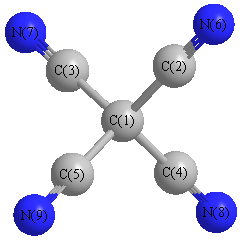Vibrational Frequencies calculated at TPSSh/cc-pVTZ
| Mode Number |
Symmetry |
Frequency
(cm-1) |
Scaled Frequency
(cm-1) |
IR Intensities
(km mol-1) |
Raman Act
(Å4/u) |
Dep P |
Dep U |
|---|
| 1 |
A1 |
2354 |
2279 |
0.00 |
|
|
|
| 2 |
A1 |
579 |
561 |
0.00 |
|
|
|
| 3 |
E |
566 |
548 |
0.00 |
|
|
|
| 3 |
E |
566 |
548 |
0.00 |
|
|
|
| 4 |
E |
109 |
106 |
0.00 |
|
|
|
| 4 |
E |
109 |
106 |
0.00 |
|
|
|
| 5 |
T1 |
342 |
331 |
0.00 |
|
|
|
| 5 |
T1 |
342 |
331 |
0.00 |
|
|
|
| 5 |
T1 |
342 |
331 |
0.00 |
|
|
|
| 6 |
T2 |
2345 |
2270 |
8.17 |
|
|
|
| 6 |
T2 |
2345 |
2270 |
8.17 |
|
|
|
| 6 |
T2 |
2345 |
2270 |
8.17 |
|
|
|
| 7 |
T2 |
1053 |
1019 |
33.45 |
|
|
|
| 7 |
T2 |
1053 |
1019 |
33.45 |
|
|
|
| 7 |
T2 |
1053 |
1019 |
33.45 |
|
|
|
| 8 |
T2 |
551 |
533 |
0.01 |
|
|
|
| 8 |
T2 |
551 |
533 |
0.01 |
|
|
|
| 8 |
T2 |
551 |
533 |
0.01 |
|
|
|
| 9 |
T2 |
144 |
139 |
12.36 |
|
|
|
| 9 |
T2 |
144 |
139 |
12.36 |
|
|
|
| 9 |
T2 |
144 |
139 |
12.36 |
|
|
|
Unscaled Zero Point Vibrational Energy (zpe) 8792.5 cm
-1
Scaled (by 0.9683) Zero Point Vibrational Energy (zpe) 8513.7 cm
-1
See section
III.C.1 List or set vibrational scaling factors
to change the scale factors used here.
See section
III.C.2
Calculate a vibrational scaling factor for a given set of molecules
to determine the least squares best scaling factor.
Charges, Dipole, Quadrupole and Polarizability
Charges from optimized geometry at TPSSh/cc-pVTZ
Charges (e)
| Number |
Element |
Mulliken |
CHELPG |
AIM |
ESP |
| 1 |
C |
0.052 |
|
|
|
| 2 |
C |
0.008 |
|
|
|
| 3 |
C |
0.008 |
|
|
|
| 4 |
C |
0.008 |
|
|
|
| 5 |
C |
0.008 |
|
|
|
| 6 |
N |
-0.021 |
|
|
|
| 7 |
N |
-0.021 |
|
|
|
| 8 |
N |
-0.021 |
|
|
|
| 9 |
N |
-0.021 |
|
|
|
Electric dipole moments
Electric dipole components in Debye
(What's a Debye? See section
VII.A.3)
| |
x |
y |
z |
Total |
| |
0.000 |
0.000 |
0.000 |
0.000 |
| CHELPG |
|
|
|
|
| AIM |
|
|
|
|
| ESP |
|
|
|
|
Electric Quadrupole moment
Quadrupole components in D Å
Polarizabilities
Components of the polarizability tensor.
Units are
Å
3 (Angstrom cubed)
Change units.
| |
x |
y |
z |
| x |
9.746 |
0.000 |
0.000 |
| y |
0.000 |
9.746 |
0.000 |
| z |
0.000 |
0.000 |
9.746 |
<r2> (average value of r
2) Å
2
| <r2> |
282.595 |
| (<r2>)1/2 |
16.811 |
